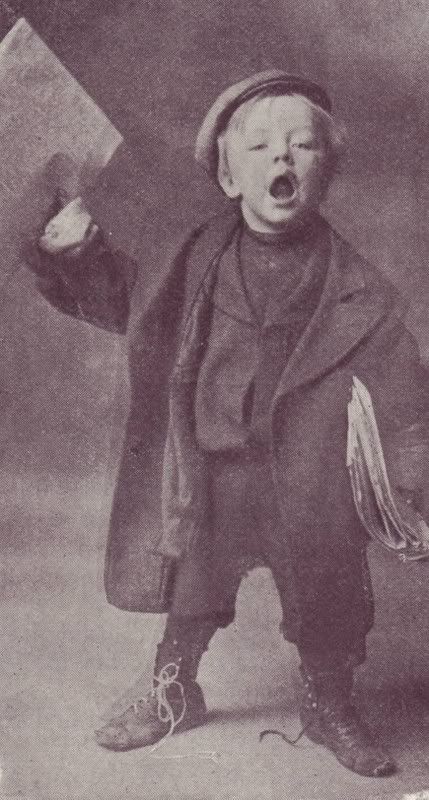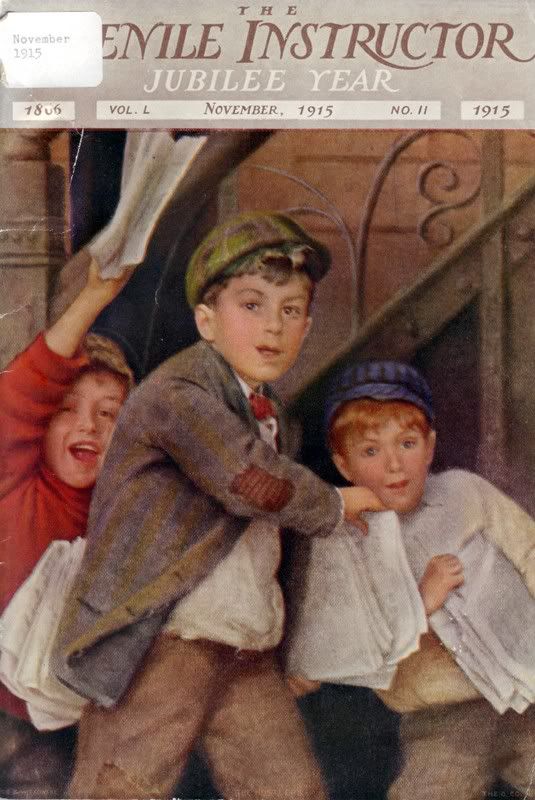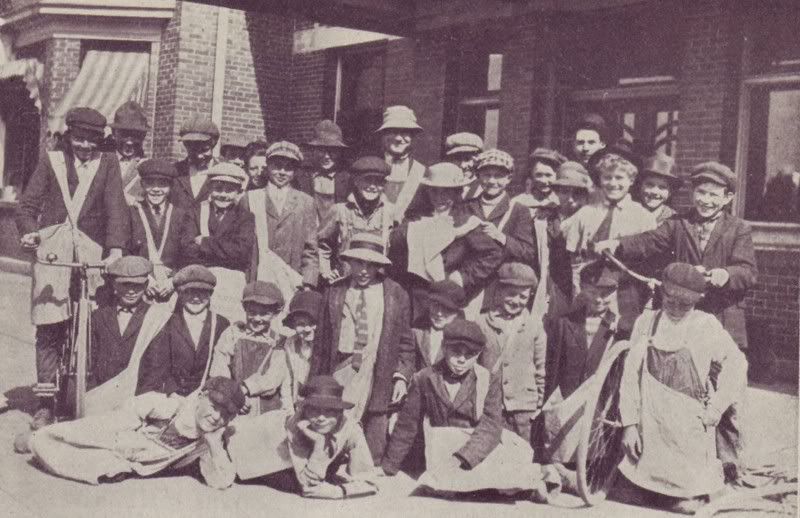 The ragged and suffering yet hardworking boy with a heart o’ gold was a staple figure in Victorian literature. One poem tells about a man who encountered a newsboy on a snowy evening, went home to his own warm fireside, then decided to rescue the child from the streets and raise him as a son.
The ragged and suffering yet hardworking boy with a heart o’ gold was a staple figure in Victorian literature. One poem tells about a man who encountered a newsboy on a snowy evening, went home to his own warm fireside, then decided to rescue the child from the streets and raise him as a son.
Well, I arose to go,
And bring the little outcast
To the shelter of my home;
No longer should he suffer want,
No longer homeless roam.
Alas! When the poet found the boy, he was lying in an alley surrounded by others of his fraternity:
I heard him say, “I’m dying;
I’m going there to-night,
Where father and my mother is –
It’s warm up there, and bright.”
And then he said, “Good-bye, boys.”
The little outcast died.
His papers folded carefully
Were lying at his side.
Too late I sought to save him;
He lived unloved, unknown, –
Only a little orphaned lad,
Cast out to die alone.
 I suspect that their lives were pretty tough, if not often as bathetic as this poem suggests. The boys worked early and late, for mere pennies, and were subject to foul weather, bullies, and the dangers of darting in and out of traffic and between train cars.
I suspect that their lives were pretty tough, if not often as bathetic as this poem suggests. The boys worked early and late, for mere pennies, and were subject to foul weather, bullies, and the dangers of darting in and out of traffic and between train cars.
The iconic newsboy had his place in early 20th century Mormon culture. Several of the ads run by Beneficial Life Insurance on the back covers of LDS publications featured newsboys in their little morality plays, implying that if you didn’t insure your life with Beneficial, your own noble lad would be reduced to the miserable life of a newsboy in order to support his widowed mother after your premature death. Newsboys found their way onto the front cover of at least one issue of the Juvenile Instructor, too, in 1915.
One noble newsboy played a starring role in a 1925 Conference address by John A. Widtsoe:
I like to recall my experience with a little newsboy. My wife and I stood at the west door of the Hotel Utah, in the company of a most distinguished American and his wife. We were talking about the gospel of Jesus Christ as taught by the Latter-day Saints. Somebody said something about the Priesthood, and mention was made of the fact that in this Church all men may make themselves worthy to hold the Priesthood. Someone remarked – perhaps my wife – that even the boys after a certain age held the Priesthood. Just then a little lad came along the sidewalk calling out the afternoon paper – “Deseret News! Deseret News!” On the spur of the moment I said: “Perhaps that little boy holds the Priesthood.” I called him to me. He thought I was a tourist, about to buy a paper. I said: “Are you a ‘Mormon,’ my boy?”
He straightened up, put his heels together, looked me in the eye, and said “I am.”
I said: “Do you hold the Priesthood?”
He said: “Yes, sir, I hold the Priesthood.”
I said: “What office in the Priesthood do you hold?”
The little boy gave me the salute of the Boy Scout and replied: “I am a Deacon, sir.”
There was the fearlessness of the child, the pride of his possession, though understanding only as a child, dimly, the meaning, the spirit and the vastness of this latter-day cause. We who have grown to maturity, must possess, in a larger degree, the same fearlessness to conquer ourselves and to make ourselves worthy of the call which has come to us, to go out to teach the nations that which we have received.
Newsboys worked seven days a week – no Sabbath for them. This bothered the Sunday School board in the Utah Stake. In the 19-teens, the Sunday train bringing newspapers from Salt Lake arrived in Provo about 9:30. Because Sunday School was always held at 10:00, the approximately 40 Provo boys who earned their living peddling papers on Sunday couldn’t attend Sunday School.
The Provo train depot was within the boundaries of the Provo Sixth Ward (a ward I once lived in), so the Sunday School board spoke to the Sixth Ward bishop and arranged to use his building for an early session – 8:30 to 9:15 – of Sunday School tailored especially to the interests of the newsboys. Soon the class was averaging between 25 and 30 boys every Sunday morning. Did they come for the stories? the music? the refreshments donated by the Startup Candy Company?

As simple as it seems, this Sunday School was a major break from well-established Mormon traditions of what constituted a Sunday School and when and for whom it was held. These boys – pictured in about 1917 – seem to have been pleased by the efforts of teachers C.R. Johnson, Hermese Peterson, and Mamie Huish, all of Provo.
Continue reading at the original source →



